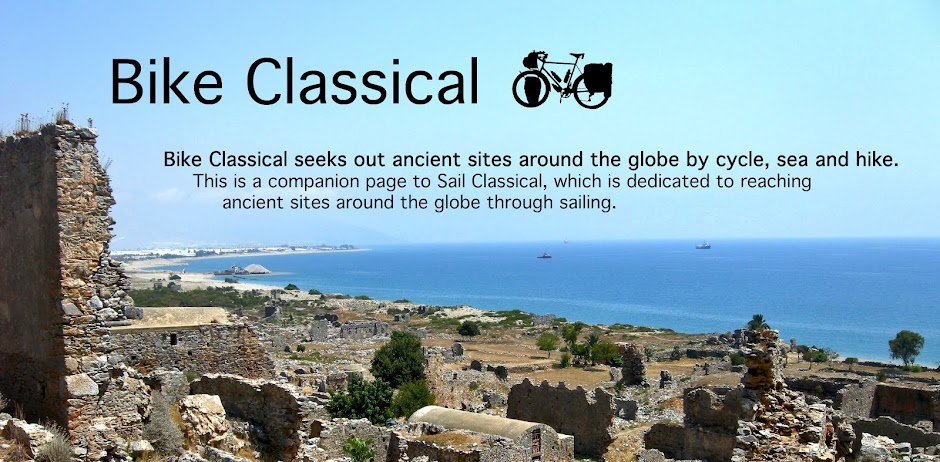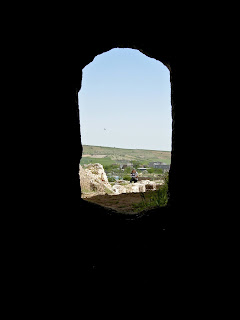Photos by Jack A. Waldron
Ancient Perre (also spelled, Perrhe) is now called Orenli, but is probably still known by its original village title, Pirin.
Today, the same route crossing the Taurus mountain range is used by all varieties of traffic, including bicycles, between Malatya (ancient Melitene) and Adiyaman, as Perre is no longer the important crossing staging point it’s fresh water spring once made it (pictured below).
The Roman era marble fountain (protective spring structure) is located in the center of the village, and is still in use today.
‘Cesme’ in English is ‘spring’, and ‘Roma’ is ‘Roman’, but there are no camped armies, or caravans preparing for the mountain crossing, just modern vehicles zooming past this ancient staging point.
Pictured below, a deep look at the inner structure of this Roman fountain.
I’m not sure why the clay pipes (pictured above) have been placed in the spring, perhaps to clean them slowly, or, to funnel the water for clear drinking?
As for the rest of the ancient city, I’m afraid it lay under the village.
As with the numerous other villages around Turkey that lay atop ancient ruins, as the villagers move, pass away, etc., the houses and land are slowly bought up by government entities, and eventually excavated.
Walking up behind and atop the Roman fountain, we can see that the structure is indeed elaborate, and continues under the more recent black top pavement.
Stepping closer, it becomes obvious that there are various marble building members scattered atop the spring structure, which may have been part of a fountain house.
Walking toward the hills, one can’t help but try to locate the unexcavated theater, which could possibly be captured in the photo below?
The theater masks pictured below are on display at the Adiyaman Archeological Museum, and are listed as being found in the Perre necropolis.
The spring poppies in Turkey never let one down for color, especially when growing in the midst of an ancient city, though I must say, the wild Rocca I picked in the ancient city of Laodicea On The Lycus really was extra delicious.
Once again, the scenery around Adiyaman doesn’t fail to awe.
The village in the background is Orenli (Pirin), and I am standing at the edge/beginning of the expansive Necropolis.
The photo below is of an ongoing excavation that is not yet open to the public. It is directly above the village, and may be another necropolis.
Pictured below, a Byzantine era lion. I always see these Byzantine lions as an aspect of modern art, or the beginning of a genre of modern art. This too was labeled as having been found in the Perre necropolis.
Pictured below, just another example of Byzantine modern art. This one I quite like, and it does seem to have a greater function than simply being a stool. This too was found in the Perre necropolis.
Continuing on to the main site, which is the Necropolis, a dead city emerges, with cisterns, catacombs, and building members from freestanding, or partially freestanding tombs.
A city indeed! There are many artifacts in the Adiyaman Archeological Museum that were found in the Perre necropolis, photos of which I will share here, such as these Roman glass pieces (pictured below).
Just outside the entrance to the museum was the colossal statue foot you see pictured below. I was really surprised to find such size in an antiquity that had been found at Perre.
Pictured below, a Roman era bronze serpent that appears to have escaped from the head of Medusa. I am very curious to discover for what purpose such an object was created?
This row of mill stones on display in front of the Adiyaman Archeological Museum (pictured below) are labeled as having come from the Perre necropolis.
As I have seen with my own eyes several necropolises around Turkey being used as living and industrial sites due to the protection the tombs can offer from the elements, I can imagine the necropolis at Perre having been similarly used. Perhaps the necropolis became a center for the milling of grains?
There are so many rock cut tombs, that one could spend forever investing them all, and some archeologists still do.
The tombs have been robbed, combed over, lived in, and sheltered live stock, and still grave goods are occasionally found, such as this head, and the jewelry on display.
The necropolis has so many small nooks, secret passages and hidden chambers built within, over, and on top of each other, that I am certain there is much more to be discovered here.
For range reference, the tomb pictured above in the center bottom of the photo can be seen in the photos above and below.
Some sarcophagi were protected within the rock honed tombs (sculpted boxes with lids, or, lids atop rectangular burial holes, while others were placed outside to weather in the elements.
One thing is for certain, objects left for the deceased, such as the comb pictured above, or the toy chariot pictured below, both from the Hellenistic era, and both found in the Perre necropolis, were not of interest for grave robbers.
This necropolis makes for a fascinating empirical study, as I see tombs, quarries, homes, staircases, workshops, and on, and on, and on.
The round port light in the left of the photo below allows a plentiful portion of light into the back chambers of the tomb.
Stepping inside, we go from 28 Celsius to 18, and the darkness is at first blinding, but oh those port lights!
As you can see below, the tombs become very navigable with the help of the intense Turkish sun, meaning, they are very dark, hence the windows being cut into the walls.
This multi space burial tomb was most likely purposed for a large family, plus extended family members as the decades passed, eventually raided for any treasure, and finally, a dwelling for a local family.
Pictured below, the head of Aphrodite, and below that, the head of Zeus. Both are from the Hellenistic era, and are on display at the museum, listed as being found in the necropolis.
As Catholics often have a statue of Mother Mary in front of their house (as my grandmother did), I can imagine statues of the Hellenistic or Roman gods adorning the chambers of the necropolis.
The burial tomb entrance pictured below comes alive as the Egyptian(?) reliefs come to view (that may still have rough thinly painted surfaces), however, is it simply my imagination at work here?
I see on the right side, an archaic figure with an Egyptian headress and short skirt walking or standing?
Continuing through the necropolis, I found this natural wall that divides two sections quite aesthetically pleasing.
Perhaps once protected from the elements by a stone or wooden superstructure, remnants of what looks like a stone block floor can be seen (pictured below).
These tombs were used and reoccupied many times over the centuries by the Hellens, the Romans, the Byzantines, the Ottomans, farmers, shepherds, and so on. Therefore, many inscriptions can be found from these various cultures.
Pictured above and below, inscriptions and sculpture from the Hellenistic period found in the vicinity of the necropolis at Perre, on display at the Adiyaman Archeological Museum.
Here we can see the same tombs as above in the left of the photo, along with hollowed out sarcophagi blocks that once would have been protected by lids (pictured below).
As the pillar bases pictured below will attest to, some of the burial tombs were partially or fully constructed and stood independently from the stone necropolis/quarry walls.
Here we have two column building members, though I can’t truly place them as capitals or bases, though I suspect the one pictured above is a column base, while the one pictured below is a capital?
The square building member pictured below is also most likely a column base for one of the collapsed tombs, or, it could be a dedicatory base, along the lines of those pictured further down.
The reason I don't think the square cut base pictured above is a dedicatory base, is because the sculpting is very rough, off proportion, and I see no dedication.
These dedicatory bases from the Roman period (pictured above and below) are labeled as originating from the Perre necropolis, and I don't doubt that, however, from my experience, such bases have often been located around the agora, or, the road leading into the city, which usually passes by the necropolis, as in the case of Perre.
No city would be complete without its water supply, and to aid grieving families with their customary visits to pay respects, and for those who worked in the area, cisterns can be found throughout the necropolis (pictured below).
This cistern is quite deep and narrow, and descends to a door opening with the water accessible from both within the substructure or, from ground level via a shaft.
The necessity for, and availability of fresh spring water before crossing the mountains to Melitene (Malatya), probably ensured some prosperity for the people inhabiting the city as a whole.
I can imagine some ancient citizens using the sunken cisterns as respites from the summer heat. Pictured below, a view back up the staircase.
Pictured below, a flash shot of the door opening at the bottom of the staircase.
Here we have yet another of the numerous sunken staircase cisterns that can be found throughout the necropolis (pictured below).
I didn’t take photos from inside this cistern as it was partially blocked by debris. I doubt I will still be alive when greater Perre is finally vacated by locals and excavated.
One of the more curious sculptures on display in the courtyard of the Adiyaman Archeological Museum is this so-called Byzantine stele (pictured below). To me, this sculpture more resembles Jupiter Dolichenus, a local god centered in ancient Duluk, in this ancient realm. This would have been a Roman exoticism and a derivation of Teshub, the Hurrian god of the sky, or storm god. The Romans meshed Jupiter and the local Teshub together in order to bring the local population closer in harmony with the empire, a common practice.
*All photos and content property of Jack A. Waldron (photos may not be used without written permission)
**If you'd like to help with future postings, please feel free to support them through PATREON:



























































